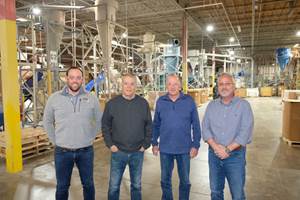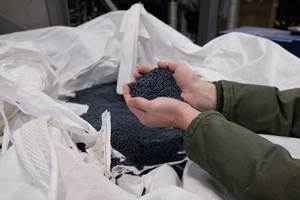Avoid Four Common Traps In Granulation
Today, more than ever, granulation is an important step in the total production process. Our expert explains a few of the many common traps to avoid when thinking about granulators
Today, more than ever, granulation is an important step in the total production process. For many processors, specifically those making industrial parts, regrind has often been considered a problem or a necessary evil. Now, due to the higher cost of materials combined with increased demands from customers to include reground and/or recycled materials in the product, the use of regrind should be viewed as a significant marketing opportunity as well as a cost-saving method.
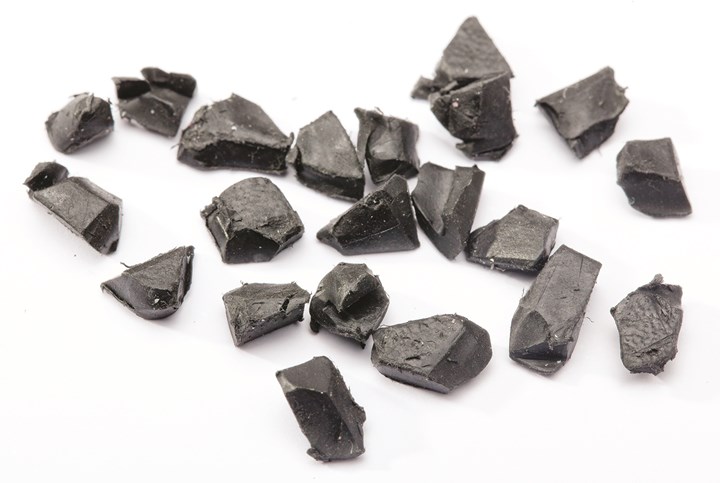
Regrind is considered good when it is free from dust/fines and of uniform size
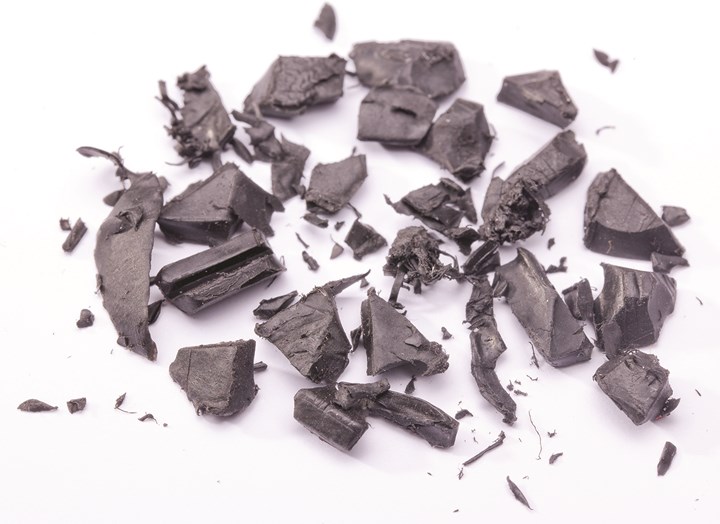
Bad regrind has excessive dust/fines and is non-uniform in size.
With the advances in cutting technology and machine design, reductions in energy consumption, and increased automation available for size-reduction systems, there are many cost-effective solutions available to provide quality regrind to the manufacturing process without adversely affecting production rates, part quality, or the plant environment. The following are just a few of the many common “traps” to avoid when thinking about granulation and granulators specifically.
TRAP 1: A GRANULATOR UNSUITED FOR THE TASK
A major trap is to think that a granulator is just a granulator and that horsepower and throat size are all you need to know to specify an effective granulation process. Nothing could be further from the truth. Ask any blow molder who has been in the business for more than 10 years and you will more than likely find that they have experienced their products “floating” on the rotor. The product bounces around in the cutting chamber for long periods before it is finally ingested by the rotor. This leads to lower throughputs than expected from the machinery as well as very poor regrind quality.
In order to cut material efficiently, you’ll need a granulator configured specifically for your application. If not, expect higher energy consumption, excessive dust and noise, lower capacity, and increased knife wear. Today, most sophisticated granulator machinery suppliers offer modular products that allow the builder to configure core machine components to match the specific application requirements.
You’ll need at least seven critical pieces of information to size the granulator appropriately:
•Application or process: Each process—blow molding, injection molding, extrusion, recycling—imposes different demands on a granulator.
•Material: Different materials can react very differently in a granulator.
•Method of feeding: Will it be manual, conveyor, robot, or roll feeding, relief head, etc.?
•Part description: A physical description of the intended parts, such as bottles, runners, or sheet, is essential to proper configuration of the granulator.
•Part dimensions: Try to capture the range of potential part sizes include largest and smallest, thickest and thinnest.
•Capacity: What lb/hr or kg/hr is expected?
•Screen size: What final particle size do you want to reintroduce into your process?
Through careful analysis of the above information, an experienced size-reduction professional will be able to design and recommend an appropriate solution for what the processor is trying to achieve. This should include options on rotor and cutting-chamber design and the number of fixed knives required. Effective hopper design will be chosen to accommodate the parts and eliminate flyback generated during granulation.
In addition to matching the machine to the application, machine builders will be able to provide the processor with a list of options that will help them with running the machine, such as high-level and high-amp alarms, soundproofing of the hopper and base, and a variety of evacuation and electrical control options.
TRAP 2: A GRANULATOR THAT IS HARD TO MAINTAIN
Maintenance of granulators and their critical cutting components is the most neglected area of service in many plants. Maintenance is often put off because of time considerations—that is, the granulator design does not lend itself to the task. Poor or inadequate instruction manuals and lack of supporting solutions to simplify functions such as knife servicing make matters worse. Lack of maintenance alone can lead to the most common problem associated with regrind—poor quality granulate with excessive fines and high dust content in the material and in the plant environment.
The two major reasons for dust and fines are dull and/or improperly gapped knives. The sharper the knives, the more efficiently the granulator will cut the scrap, especially with soft, energy-absorbing materials such as thermoplastic rubber or polyolefin films. Sharper knives produce a cleaner cut without pulling and tearing, yielding higher throughputs, less dust and fines, less noise, and greater energy efficiency.
Today, most leading granulator manufacturers realize that with the increasing cost of materials and shrinking maintenance budgets, it’s important that granulators be designed for easy cleaning and knife maintenance. Quick and safe access to the heart of the granulator is critical for optimal productivity.
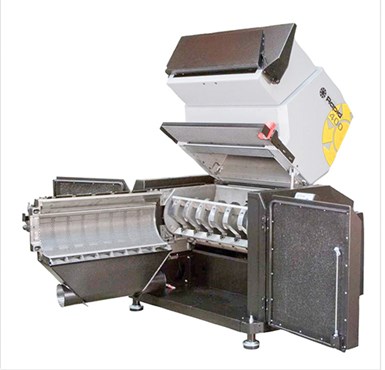
Granulators today are generally designed with maintenance in mind, offering safe and easy access to the heart of the unit.
Think about a processor running multiple colors and materials in short-run production cycles, who needs to clean the machine thoroughly between each run to avoid contamination. The granulator must be designed to allow the operator to visibly confirm that the machine is clean while ensuring that the operator is safe when inside the machine. That is, the granulator should have redundant safety switches for maximum safety and should have features such as power-assisted tilt-back hoppers, rotor locking devices, and easily accessible and removable screen cradles and screens. Visibly clean means the operator should have visual paths to all areas of the machine—no hidden nooks and crannies—to inspect and confirm the machine is free from all previous colors or materials that may lead to contamination in the next run.
TRAP 3: A GRANULATOR WITH A POOR KNIFE DESIGN
Another common trap is knife positioning and design with little or no scissor-cutting action, poor rotor design (static rotating knives), non-optimized location of fixed knives, and less than optimal rotor knife speed. Any or all of these can lead to non-uniform regrind with high dust and fines content and also lead to a high level of wear and tear on the granulator.
Always look for a feature known as “adjustable rotating knives.” These knives are the ones bolted to the rotor. Along with the fixed knives, they must be kept properly gapped and sharpened.
In older granulator designs, these knives are generally fixed to the rotor and thus not adjustable. Because you remove knife material whenever you resharpen, the effective rotor diameter can become smaller and smaller over the life of the knife. Typically about 10 mm or 3/8 in. of knife material can be removed over several resharpenings.
With an older machine design, the normal procedure is to move the fixed knives forward to compensate for the material ground off the rotating knives. This results in a reduction of the cutting diameter of the granulator and increases the distance from the rotating knife tips to the screen. As you also cut material against the screen, this increased distance between the knife tips and the screen leads to the “balling” of the material on top of the screen, and a much longer residence time of the material in the cutting chamber, generating considerably more dust and fines.
Additionally, moving the fixed (bed) knife forward to compensate for the shortened rotating knives leads to creation of a “shelf” in the cutting chamber, where the material can easily build up. This shelf impedes the feed into the down stroke of the cutting chamber and results in less-effective cutting.
Pre-adjustable knives and cassette knives are features found on more modern machine designs. Recognizing the importance of knife sharpness and gap, and their relationship to final granulate quality, many machine manufactures have standardized on more maintenance-friendly designs for the knives. Pre-adjustable knife fixtures that allow the maintenance staff to set the critical gap outside the machine reduce the overall downtime of installing and gapping resharpened knives. Gone are the days of sticking feeler gauges into dark crevices while trying to adjust knives in the machine.
Moreover, because the fixed knives are coming into a machined stop in the cutting chamber, rotating knives can be gapped independently, allowing each rotating knife to have the exact same gap with respect to the fixed knives. This is impossible with static (non-adjustable) rotating knives. Another benefit of adjustable rotating knives is the ability to sharpen each knife independently rather than together as a set. This allows for the minimum amount of material to be ground off each knife during each resharpening, resulting in longer overall knife service life.
TRAP 4: A GRANULATOR THAT IS OVER-FED
Many processors seemingly try to destroy their granulator not long after receiving it, in the name of “testing the limits” of what the capacity of the granulator really is. Your granulator was sized for a particular application and, hopefully, it is still used in that same application. But often when an existing granulator is wheeled across the shop floor to perform its duties for a different part or job, the materials are different, the throughput is different…in fact, everything is different from what the granulator was originally designed for.
Over-feeding your granulator will obviously back it up, reducing productivity. The decrease in air flow associated with a completely full cutting chamber leads to less-effective evacuation of the machine. And infeed material sits on top of the rotor, waiting to be ingested into the cutting chamber. That material, because it is riding on top of the knives and not being cut, is dulling your knives at a faster than normal rate. In some cases of over-feeding, the granulator approaches the maximum amp load capacity of the drive motor and simply jams or ceases working.
Just as it’s better to remove regrind automatically from your granulator with an appropriately sized evacuation system, it’s also better to automatically meter-feed your granulator—either with a robot or a conveyor. That way, there is no chance of over-feeding your unit.
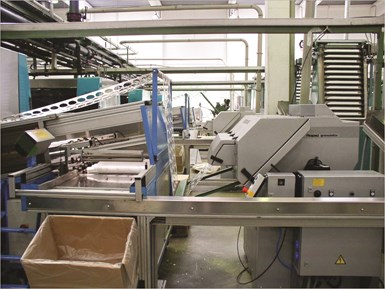
It’s best to automatically meter-feed your granulator—either with a robot or a conveyer. Shown here is a well-designed inline granulation system featuring roll-feed and an evacuation system.
There are several electrical options to help with optimized feeding of the granulator. High-amp alarms can tell you when you are working the drive motor too hard and help the operator understand when to back off the feed when feeding manually. High-level alarms can help the operator understand and avoid evacuation problems, for example if the feed rate is exceeding the evacuation rate it may be as simple as waiting for the evacuation system to catch up. It also may save the system from plugging up entirely, resulting in potentially expensive damage to the granulator motor.
It’s important to understand how the granulator is sized for a throughput rate. There is a big difference between instantaneous rate and intermittent rate, the latter generally being how the granulator is sized.
Let’s say the granulator is sized for 2000 lb/hr: This generally means that the machine should be fed at a rate of approximately 33 lb/min (2000 ÷ 60). If you put 100 lb of material in the hopper in a matter of seconds, don’t expect the granulator to perform. This is a very common occurrence with hand-fed granulators.
It is also important to avoid under-feeding. If your granulator sits idle and the rotor spins without parts inside, the energy efficiency is greatly decreased. You can and should expect a certain throughput rate from your granulator, but if your scrap is sitting next to your machine in a gaylord or storage area, you are definitely not getting the most from your unit.
What inevitably happens is that an over-eager operator dumps the whole box into the granulator. The result: downtime. Regular, steady feeding of your granulator is best for you and for the machine.
Despite their status as second-class citizens, granulators can help processors be more efficient and profitable. A basic understanding of the traps in granulation and the areas where granulators need the most attention can help you plan for the purchase of a granulator or understand the importance of your maintenance schedule to ensure a long, productive life for your unit.
ABOUT THE AUTHOR: Kirk Winstead is CEO of the Rapid Granulator Group of Bredaryd, Sweden, and is located at Rapid Granulator, Inc., in Cranberry Township, Pa. During his 25 years with Rapid, he has worked in a variety of capacities with emphasis on design and sales of size-reduction equipment and systems primarily for the plastics industry. Contact: (724) 584-5220; rapidgranulator.com.
Editor’s Note: Winstead was with Rapid Granulator when this article was written. He is now president of and COO Conair Group.
Related Content
Evolving Opportunities for Ambitious Plastics Recycler
St. Joseph Plastics grew from a simple grinding operation and now pursues growing markets in recycled PP, food-grade recycled materials, and customized post-industrial and post-consumer compounds.
Read MoreCoinjection Technology Showcases Recycled Material Containment
At Fakuma, an all-electric PXZ Multinject machine sandwiches a black core made of mechanically recycled PC/ABS within an outer layer made of chemically recycled ABS.
Read MoreNew Facility Refreshes Post-Consumer PP by Washing Out Additives, Contaminants
PureCycle prepares to scale up its novel solvent recycling approach as new facility nears completion.
Read MoreExtrusion Technology Extended to Injection, Enabling Up to 100% Regrind Usage
Twin-barrel (shot-pot) press can handle more regrind, offers other benefits to molders.
Read MoreRead Next
Making the Circular Economy a Reality
Driven by brand owner demands and new worldwide legislation, the entire supply chain is working toward the shift to circularity, with some evidence the circular economy has already begun.
Read MoreBeyond Prototypes: 8 Ways the Plastics Industry Is Using 3D Printing
Plastics processors are finding applications for 3D printing around the plant and across the supply chain. Here are 8 examples to look for at NPE2024.
Read More






